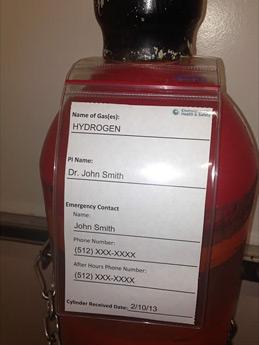Compressed gas cylinders are a common item in many workplaces, from machine shops to laboratories, and clinics. In addition to the hazard of the gas, gas cylinders are bulky and create a significant manual handling risk. The slim, cylindrical shape of a gas cylinder coupled with its’ heaviness can make them unstable when standing.
Handling of gas cylinders could involve a wide variety of tasks including lifting, lowering, pushing, pulling and carrying. If any of these tasks are not carried out properly then there is a risk of injury. Gas cylinders typically have a large height to diameter ratio and a high center of gravity which may render them unstable. Freestanding cylinders may fall over causing adjacent cylinders to fall. Never attempt to stop a falling cylinder, as it could cause harm or come into contact with another nearby cylinder.
Compressed gases can be divided into three major groups:
• Liquefied Gases (such as anhydrous ammonia, chlorine, propane, nitrous oxide & carbon dioxide)
• Non-liquefied Gases (e.g. oxygen, nitrogen, helium & argon)
• Dissolved Gas (acetylene)
Pressure inside the compressed cylinder can reach extremely high levels. Therefore, proper release of the pressure is a very important safety precaution. Improper release and leaks pose a serious fire, explosion, asphyxiation, and inhalation hazard.
Safe Handling, Storage & Transportation
Gas cylinders possess a variety of different safety devices including pressure-relief valves, rupture discs, and fusible plugs. Different gases require different safety measures on the cylinders. For instance, some gases are toxic and pyrophoric; release of these gases through a safety device would be hazardous.
Cylinders should not be dragged or rolled horizontally along the ground. This may cause damage to the integrity of the cylinder, the identifying marks and symbols on the outside of the cylinder, or accidentally open the valve.
Cylinders should not be moved with the valve open and should never be transported with the regulators and hoses attached. Always secure a safety cap on the cylinder valve prior to moving. Always secure with a chain, a cylinder to a proper cylinder cart when transporting.
Cylinders should be stored upright at all times. Cylinders must always be properly secured (even when empty) with a chain or strap. If cylinders need to be lifted by hand from a horizontal position, avoid injury by using correct lifting methods.
Ensure that cylinders are clearly identified. Labels must not be defaced or removed. Do not accept or use cylinders that have labels that are not legible. Instead, separate the non-legible cylinders and return them to the supplier.
Do not use the cylinder’s color to identify the contents. Do not repaint the cylinder.
All gas lines leading from a compressed gas source must be clearly labeled.
Never drop cylinders. Additionally, do not strike them against one another or some other surface.
Do not subject cylinders to artificially low temperatures or temperatures above 125 F. Do not place them next to heat sources or allow a flame to contact any part of the cylinder.
Store compressed gases based on their hazard class (flammable, asphyxiant, and oxidizer, toxic, and corrosive). Provide adequate space or segregate by partitions. Incompatible gas cylinders such as hydrogen (flammable) and oxygen (oxidizer) should be stored at least 20ft apart. A firewall (partition) five feet high with a half-hour fire rating can be substituted. Other examples of oxidizing gases include chlorine, nitrous oxide, and fluorine.
Corrosive and toxic gases present serious hazards: keep exposures as low as possible and avoid inhaling or contact with skin or eyes. Easily accessible safety showers and eyewash stations must be available for lab workers using corrosive gases such as ammonia and chlorine.
Most toxic gases require special storage (ventilated and sprinklered gas cabinet), specific gas delivery systems, and specialized training.
The primary hazard for acetylene and propane is flammability. Both can be asphyxiants. Acetylene may decompose violently under pressure in excess of 15 pounds per square inch gauge. These two gases can be stored together. Always store flammables in a well-ventilated area away from oxidizers, open flames, sparks, and other sources of heat or ignition.
Regularly inspect cylinders for exterior corrosion, denting, bulging, or gouges. Return any questionable cylinders to the gas supplier or contact EHS for assistance. Cylinders that have leaking regulators, valves, or other equipment should be taken out of service.
Proper ventilation is vital. Assess the specific ways your workplace stores, handles, and uses compressed gases. An assessment can reveal if existing ventilation controls and other hazard control methods are adequate. Contact EHS for assistance.
Use a pressure-reducing regulator or separate control valve to safely discharge gas from a cylinder. Discontinue use and contact the supplier if a cylinder valve is difficult to operate. Wrenches should not be used on valves equipped with hand wheels. If the valve is faulty, tag the cylinder, identify the problem, and notify the supplier.
Personal Protective Equipment (PPE)
Foot protection. Safety boots/shoes, footwear with metatarsal protection is recommended (particularly when transporting cylinders). At a minimum, wear close-toed shoes.
Hand protection. Use appropriate gloves for handling cylinders and working with gases.
Eye protection. Wear safety glasses.
Use additional PPE as required (e.g., a lab coat).
Training
University students, faculty, staff, and affiliate researchers who work in labs with compressed gases must complete OH 204 Compressed Gases training. If cryogens are also present in the lab, complete OH 241 Cryogen Safety.
Name Tag for Compressed Gas Cylinders
EHS can provide a plastic sleeve that holds a Name Tag for compressed gases. Each user can complete and print their own tag by using this template.
Feel free to tag all your compressed gas cylinders. At a minimum, hazardous gases should have an attached tag. Download the tag template (PDF).

